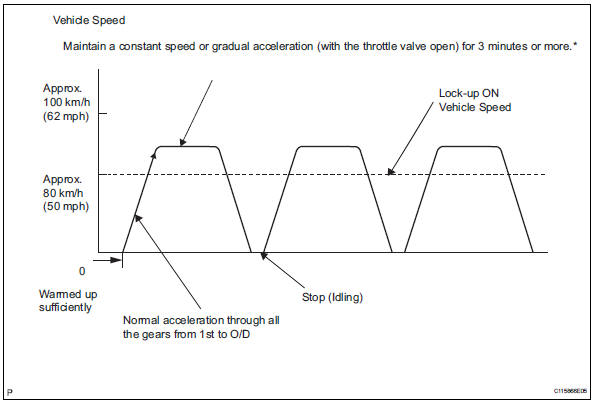Toyota RAV4 (XA40) 2013-2018 Service Manual: Monitor drive pattern
- Test monitor drive pattern for ect
Caution:
Perform this drive pattern on a level surface and strictly observe the posted speed limits and traffic laws while driving.
Hint:
Performing this drive pattern is one method to simulate the ect's malfunction detection conditions.
The dtcs may not be detected through ordinary, everyday driving. Also, dtcs may not be detected through this drive pattern.
- Preparation for driving
- Warm up the engine sufficiently (engine coolant temperature is 60°c (140°f) or higher).
- Drive the vehicle when the atmospheric
temperature is -10°c (14°f) or higher.
Malfunction is not detected when the atmospheric temperature is less than -10°c (14°f).
- Drive pattern
- Drive the vehicle through all the gears.
Stop→1st → 2nd →3rd → o/d → o/d (lock-up on).
- Repeat the above drive pattern 3 times or more.
Notice:
- When using the intelligent tester, the monitor status can be found in "enhanced obd ii / data list" or under "carb obd ii".
- In the event that the drive pattern must be interrupted (due to traffic conditions or other factors), the drive pattern can be resumed and, in most cases, the monitor can be completed.
Caution:
Perform this drive pattern on a level road as much as possible and strictly observe the posted speed limits and traffic laws while driving.

Hint:
*: Drive at such a speed in the uppermost gear to engage lock-up. The vehicle can be driven at a speed lower than the speed shown in the above diagram under the lock-up condition.
Notice:
It is necessary to drive the vehicle for approximately 30 minutes to detect dtc p0711 (transmission fluid temperature sensor "a" performance).
 Manual shifting test
Manual shifting test
Manual shifting test
Hint:
Through this test, it can be determined whether the
trouble occurs in the electrical circuit or if it is a
mechanical problem in the transaxle.
If any abnorm ...
 Problem symptoms table
Problem symptoms table
Hint:
Use the table below to help determine the cause of the
problem symptom. The potential causes of the symptoms
are listed in order of probability in the "suspected area"
column ...
Other materials:
Front seats
The seats can be adjusted
(longitudinally, vertically,
etc.). Adjust the seat to
ensure the correct driving
posture.
Adjustment procedure
Manual seat
Seat position adjustment
lever
Seatback angle adjustment
lever
Vertical height adjustment
lever (driver's side only)
Power seat
Seat posit ...
Disposal
Hint:
When scrapping vehicles equipped with a seat belt
pretensioner or disposing of a front seat outer belt (with seat
belt pretensioner), always first activate the seat belt
pretensioner in accordance with the procedures described
below. If any abnormality occurs during activation of the seat ...
Abs and traction actuator (skid control ecu) communication stop mode
Description
Wiring diagram
Inspection procedure
Notice:
Turn the ignition switch off before measuring the resistances
of the main wire and the branch
wire.
After the ignition switch is turned off, check that the key
reminder warning system and light
reminder warning system ...
